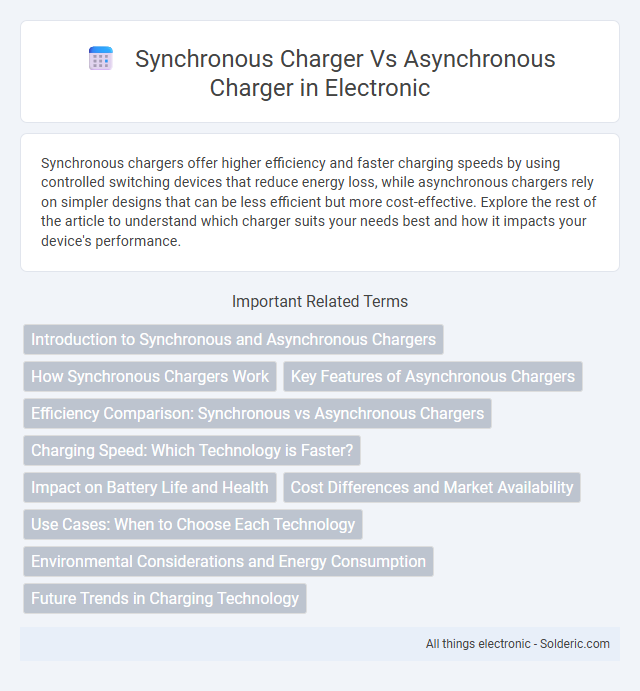Synchronous chargers offer higher efficiency and faster charging speeds by using controlled switching devices that reduce energy loss, while asynchronous chargers rely on simpler designs that can be less efficient but more cost-effective. Explore the rest of the article to understand which charger suits your needs best and how it impacts your device's performance.
Comparison Table
| Feature | Synchronous Charger | Asynchronous Charger |
|---|---|---|
| Efficiency | High efficiency due to synchronous rectification | Lower efficiency because of diode rectification losses |
| Switching Components | Uses MOSFETs or transistors operating synchronously | Uses diodes for rectification, no active switching |
| Heat Generation | Less heat generation, cooler operation | More heat due to diode forward voltage drop |
| Complexity | More complex control circuitry required | Simple design with fewer components |
| Cost | Higher initial cost due to complexity | Lower cost, simpler design |
| Application | Used for high-efficiency fast chargers | Common in low-cost, low-power chargers |
Introduction to Synchronous and Asynchronous Chargers
Synchronous chargers use MOSFETs that operate in sync with the input voltage to maximize efficiency and reduce heat generation, making them ideal for fast and energy-saving charging applications. Asynchronous chargers rely on diodes instead of synchronized switches, resulting in simpler design but lower efficiency and higher power loss. Understanding the differences between these charger types helps you choose the best option for your device's power requirements and energy efficiency goals.
How Synchronous Chargers Work
Synchronous chargers operate using synchronous rectification, where MOSFETs replace diodes to enhance efficiency by minimizing power loss during the charging process. They actively switch in coordination with the AC input to convert electrical energy more precisely, improving heat dissipation and reducing energy waste compared to asynchronous chargers. This technology is crucial in high-power applications, delivering faster and more efficient battery charging performance.
Key Features of Asynchronous Chargers
Asynchronous chargers utilize a switching frequency that is not synchronized with the input power grid frequency, allowing more flexible operation under varying loads and input conditions. Key features include simpler circuit design, reduced electromagnetic interference, and typically lower cost compared to synchronous chargers. These chargers are commonly used for applications requiring robustness and efficiency in environments with fluctuating power supply quality.
Efficiency Comparison: Synchronous vs Asynchronous Chargers
Synchronous chargers achieve higher efficiency by using MOSFETs for both high-side and low-side switches, minimizing conduction losses during power conversion. Asynchronous chargers rely on diodes for the low-side switch, which results in increased power dissipation and lower overall efficiency. Your choice of charger can significantly impact energy savings and thermal management due to these efficiency differences.
Charging Speed: Which Technology is Faster?
Synchronous chargers offer faster charging speeds due to their use of controlled switching devices that minimize power loss and improve efficiency, enabling more rapid energy transfer. Asynchronous chargers typically experience higher energy dissipation and slower charging times because of less precise switching mechanisms and increased heat generation. Therefore, synchronous technology is preferred for applications demanding quick battery replenishment and enhanced performance.
Impact on Battery Life and Health
Synchronous chargers provide more efficient power delivery with reduced heat generation, which helps maintain battery health and prolongs overall battery life by minimizing thermal stress. Asynchronous chargers, while simpler in design, often produce higher heat levels during charging, potentially accelerating battery degradation and shortening lifespan. Advanced battery management systems paired with synchronous chargers enable precise voltage and current control, further enhancing battery longevity compared to asynchronous alternatives.
Cost Differences and Market Availability
Synchronous chargers typically have higher initial costs due to their efficient power conversion and complex control circuits, making them more expensive than asynchronous chargers, which use simpler and cheaper components. Asynchronous chargers dominate the market availability because of their lower price point and widespread use in budget and mid-range electronic devices. Despite higher upfront costs, synchronous chargers are increasingly adopted in premium products where efficiency and reduced energy loss justify the investment.
Use Cases: When to Choose Each Technology
Synchronous chargers are ideal for high-efficiency applications such as electric vehicles and portable electronics where energy savings and fast charging are critical. Asynchronous chargers suit simpler, cost-sensitive systems like basic battery maintenance or small appliances where efficiency is less crucial. Your choice depends on balancing performance needs and budget constraints, with synchronous chargers offering superior power conversion efficiency.
Environmental Considerations and Energy Consumption
Synchronous chargers generally offer higher energy efficiency by minimizing energy losses during power conversion, leading to reduced electricity consumption and lower carbon emissions. Asynchronous chargers, while simpler and often cheaper, tend to have higher power losses due to their less efficient design, increasing your environmental footprint. Choosing a synchronous charger supports sustainable energy use and aligns with efforts to reduce environmental impact in electronic device charging.
Future Trends in Charging Technology
Synchronous chargers offer higher efficiency and reduced energy loss by actively controlling both power switching devices, making them ideal for future high-performance electric vehicle chargers. Asynchronous chargers, while simpler and cost-effective, face limitations in scalability and energy optimization compared to synchronous designs. Emerging trends emphasize integrating synchronous charging with smart grid technology and fast-charging capabilities to meet increasing demand for rapid, eco-friendly energy transfer solutions.
Synchronous charger vs asynchronous charger Infographic

 solderic.com
solderic.com